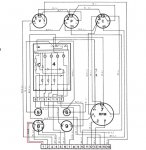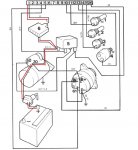kacecar
Active member
Hello.
First outing for the boat in quite a while yesterday. The engine failed to start at the end so I have a few queries.
Almost everything on the boat worked as expected but towards the end of a few hours motoring the rev counter was dead and couldn't be revived by tapping or jiggling connections - the engine was running fine though and stopped normally when it came time to sail. After sailing back to the mooring I attempted to start the engine but it appeared there was no power to the control panel. The batteries were fine and a rushed look in the engine bay and at the back of the panel failed to reveal anything obviously loose or broken. Things then got busy for a while, as I concentrated on sailing us back to the mooring, getting off the boat and then the long drive home. Having had time to reflect on the days events, I now realise that in my mind I automatically linked the rev counter issue with the lack of power to the control panel and so had missed properly checking that the stop switch was pushed fully home - dohhh!
My current thinking is that when I next get down to the boat (several days away) I need to check the stop switch, then the power to the panel, then the ignition switch itself and after that I have pretty much no idea. The rev counter problem might be entirely separate. My questions to the forum are:
a) I can't remember the effect of the stop switch - if not properly pushed back home after stopping the engine would there be power to the control panel?
b) I believe the stop switch involves a solenoid - where is it on the VP2003 (raw water cooling just in case that makes a difference)?
c) Where on the VP2003 is the sender for the rev counter?
Thanks in adavance for any ideas. I will respond as appropriate but I'm afraid I'm going to be off line for a day or so my responses might be a bit slow.
First outing for the boat in quite a while yesterday. The engine failed to start at the end so I have a few queries.
Almost everything on the boat worked as expected but towards the end of a few hours motoring the rev counter was dead and couldn't be revived by tapping or jiggling connections - the engine was running fine though and stopped normally when it came time to sail. After sailing back to the mooring I attempted to start the engine but it appeared there was no power to the control panel. The batteries were fine and a rushed look in the engine bay and at the back of the panel failed to reveal anything obviously loose or broken. Things then got busy for a while, as I concentrated on sailing us back to the mooring, getting off the boat and then the long drive home. Having had time to reflect on the days events, I now realise that in my mind I automatically linked the rev counter issue with the lack of power to the control panel and so had missed properly checking that the stop switch was pushed fully home - dohhh!
My current thinking is that when I next get down to the boat (several days away) I need to check the stop switch, then the power to the panel, then the ignition switch itself and after that I have pretty much no idea. The rev counter problem might be entirely separate. My questions to the forum are:
a) I can't remember the effect of the stop switch - if not properly pushed back home after stopping the engine would there be power to the control panel?
b) I believe the stop switch involves a solenoid - where is it on the VP2003 (raw water cooling just in case that makes a difference)?
c) Where on the VP2003 is the sender for the rev counter?
Thanks in adavance for any ideas. I will respond as appropriate but I'm afraid I'm going to be off line for a day or so my responses might be a bit slow.


